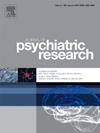Attentional biases for dynamic stimuli in emerging adults with anxiety: A preliminary eye-tracking study
IF 3.7
2区 医学
Q1 PSYCHIATRY
引用次数: 0
Abstract
While attentional biases towards negative stimuli have previously been linked to the development and maintenance of anxiety disorders, a current limitation of this research involves the use of static images for stimuli, as they cannot adequately depict the dynamic nature of real-life interactions. Since attentional biases in those with elevated anxiety remain understudied using more naturalistic stimuli, such as dynamic social videos, the purpose of this explorative study was to use novel dynamic stimuli and modern eye-tracking equipment to further investigate negative attentional biases in anxious emerging, female adults. Non-clinical participants (N = 62; mean age = 20.44 years; biologically female) completed validated questionnaires regarding their anxiety symptoms and completed a free-viewing task by watching 30-s video clips while having their eye movements tracked. The video clips were shown in side-by-side pairs (i.e., positive-neutral, negative-neutral, and positive-negative) on a split screen without audio. Overall, participants fixated more quickly on emotional videos (i.e., positive and negative) over neutral ones, with more anxious participants orienting their gaze faster to the videos, regardless of content. Moreover, individuals with greater self-reported anxiety spent more time gazing at negative videos in negative-neutral pairings, highlighting that emerging female adults with increased anxiety symptoms may show a negative attention bias when viewing social interactions. Importantly, by incorporating novel, dynamic stimuli, we expand upon prior research on attentional biases, with the potential to adapt this approach for novel interventions that may ultimately help those suffering from anxiety.
求助全文
约1分钟内获得全文
求助全文
来源期刊

Journal of psychiatric research
医学-精神病学
CiteScore
7.30
自引率
2.10%
发文量
622
审稿时长
130 days
期刊介绍:
Founded in 1961 to report on the latest work in psychiatry and cognate disciplines, the Journal of Psychiatric Research is dedicated to innovative and timely studies of four important areas of research:
(1) clinical studies of all disciplines relating to psychiatric illness, as well as normal human behaviour, including biochemical, physiological, genetic, environmental, social, psychological and epidemiological factors;
(2) basic studies pertaining to psychiatry in such fields as neuropsychopharmacology, neuroendocrinology, electrophysiology, genetics, experimental psychology and epidemiology;
(3) the growing application of clinical laboratory techniques in psychiatry, including imagery and spectroscopy of the brain, molecular biology and computer sciences;
 求助内容:
求助内容: 应助结果提醒方式:
应助结果提醒方式:


